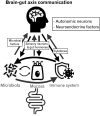Brain to Belly: Abdominal Variants of Migraine and Functional Abdominal Pain Disorders Associated With Migraine
- PMID: 34642268
- PMCID: PMC8521460
- DOI: 10.5056/jnm20290
Brain to Belly: Abdominal Variants of Migraine and Functional Abdominal Pain Disorders Associated With Migraine
Abstract
Migraine is one of the most frequent causes of primary headache and 9% of children suffer from migraines. Most children will continue to experience migraine attacks as adults, therefore it is imperative that we have a thorough understanding of this major health issue. This article considers the so-called abdominal variants of migraine, which are more commonly seen in children rather than adults: abdominal migraine, cyclic vomiting syndrome, and infantile colic. Other functional abdominal pain disorders such as irritable bowel syndrome and functional dyspepsia have also been linked to migraine in clinical studies. The common pathophysiological root of these diseases seems to be the gut-brain axis mechanism. Abdominal variants of migraine are considered pediatric precursors of migraine whereas the functional abdominal pain disorders related to migraine seem to share a pathophysiological root with no temporarily link as for today. In this review we aim to describe the epidemiological background, the current pathophysiological theories and the relationship of each disease to migraine. This review is the first to compile abdominal variants of migraine and functional abdominal pain disorders associated with migraine and we endeavor to elucidate the broad spectrum of migraine-related episodes in children.
Keywords: Abdominal pain; Child; Gastrointestinal microbiome; Migraine disorders.
Conflict of interest statement
Figures

References
Publication types
LinkOut - more resources
Full Text Sources

